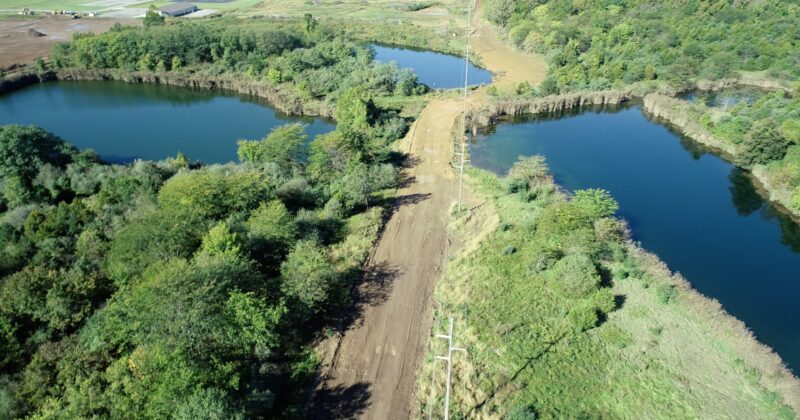
MARION, Ill. – Thanks to federal funding aimed at land restoration, a new $30 million sports complex is being constructed on the site of an abandoned coal mine in Marion. The project is expected to spur new economic opportunities for the local community.
Located in southern Illinois, an area historically known for coal mining, local residents are optimistic about the economic benefits the new sports complex will bring.
Rodney Cabaness, the developer of Oasis Sports Park, emphasized the transformative potential of the project: “The mine reclamation program is going to help completely revitalize this area around the strip mines,” he said. The Oasis Sports Park is scheduled to open sometime next year.
The centerpiece of the Oasis Sports Complex is a 150,000-square-foot dome accommodating various sports, including baseball, softball, football, basketball, soccer, tennis, and pickleball. Additionally, 15,000-square-feet of the facility will provide training for about 500 youth in baseball and softball. The complex aims to attract families from the region, providing a significant boost to local businesses, such as retail stores, restaurants, and hotels.
Cabaness, who is also co-owner of Marion’s Black Diamond Harley-Davidson, one of the largest motorcycle dealerships in the world, highlighted the broader vision: “We were trying to figure out a way to create a destination to get more people to come to southern Illinois and help grow our economy here.” He noted that while the idea of a sports complex had long been considered, funding constraints made it seem out of reach until recently.
Cabaness and his partners learned about new funding opportunities from the Illinois Department of Natural Resources (IDNR) to clean up Abandoned Mine Lands (AML) during a meeting with state and federal agencies.
AML sites, mined for coal before 1977, often cause environmental pollution and limit economic opportunities. The Surface Mining Control and Reclamation Act of 1977, originally created funding to clean up these problematic coal mine lands, but the amount and uses of the funding was limited.
In 2021, Congress passed the Bipartisan Infrastructure Law (BIL) that allocated substantial resources toward AML reclamation across the nation’s coal mining communities, including an estimated $1.2 billion toward mine clean-up in Illinois over 15 years.
“When we found out about grant funding for mine reclamation, it was magical. All the pieces came together,” he said.
Reclamation efforts of pre-1977 mine lands will include closing dangerous mine shafts, filling old tunnels, preventing the release of harmful gasses, treating acid mine drainage, reclaiming steep slopes, and planting vegetation. Contractors employing former coal workers will receive incentives during contract bidding.
Illinois Department of Natural Resources (IDNR) Director Natalie Phelps Finnie, a lifelong resident of southern Illinois, underscored the project’s significance: “This funding is a lifeline and a path to economic stability.” Finnie noted that the BIL funding provided by the Biden Administration will help protect public health, safety, and the environment, enabling local communities to repurpose restored land.
She also underscored the many entities, public and private that made the Oasis project possible. “The cooperation and commitment from IDNR, the City of Marion, Williamson County, other state agencies, and private investors is a perfect way to showcase what these BIL funds can accomplish. Not only is the BIL funding creating pathways for new economic and worker investments in Illinois communities, it’s creating hope in Illinois communities.”
Sharon Buccino, Principal Deputy Director of the Office of Surface Mining Reclamation and Enforcement in the U.S. Department of Interior, highlighted the broader mission: “Our mission at OSMRE, at its core, is about making people safer, cleaning up the environment, and encouraging economic development in coal communities. What we will be able to accomplish due to the historic investment from President Biden’s Investing in America agenda is an unprecedented, once-in-a-generation opportunity.”
John “Austin” Willis, Chief of the Alton Field Division, underscored the significance of the BIL: “I think what we see here is another great example of what the BIL was intended to accomplish – to help rebuild and invest in communities. The investment we see in Marion demonstrates what successful reclamation can ultimately lead to, helping to rebuild and revitalize communities that once supported the nation through energy and resource production. For this community, reclamation provides hope for environmental improvements, economic development, and community growth. Reclamation of abandoned mine lands is not only vital to the fulfillment of BIL, but also supports the fulfillment of the SMCRA, returning (often increasing) value to the environment and ultimately the community.”
Amanda Pankau, director of energy and community resiliency at Prairie Rivers Network, said: “The new BIL funding available for cleaning up old, unreclaimed coal mines is unprecedented. Publicly and privately owned lands are eligible for clean up, and I am excited to be working with landowners and communities to identify where these AML sites are in their communities and what potential they might have if reclaimed.”
IDNR has been awarded two BIL grants with a goal of completing 72 projects at a cost of about $68 million within the next five years. As BIL funding continues, IDNR plans to add additional projects each year. In the past year alone, IDNR has hired six new staff members to help carry out this important work. Recent legislation also allows the state to offer a 2% incentive on bids from contractors hiring two or more former coal miners.
For more information about Abandoned Mine Land reclamation projects in Illinois, contact Prairie Rivers Network at apankau@prairierivers.org or the Illinois Department of Natural Resources at 217-782-6791.
Photos available here: https://drive.google.com/drive/folders/1lwMyd-M9ghX4qB8wsadjMjROxUs0kPW5?usp=sharing







